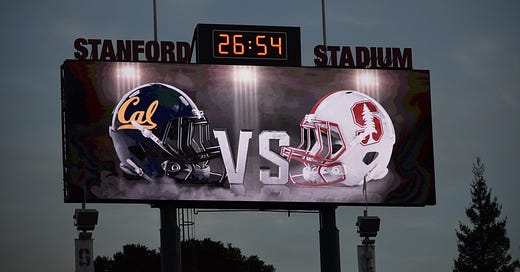The ACC Won’t Save Bay Area College Football
Cal and Stanford avoided disaster for now, but new troubles lie ahead
California and Stanford’s jump to the Atlantic Coast Conference on Sept. 1 was an act of self-preservation, a move that the two schools had to make in order to avoid being left behind in the chaos of college football’s realignment. But while the Bay Area’s most storied college football programs have momentarily retained their place in the Power 5, their move to the ACC won’t bring either program back to national prominence.
Through 10 games this season, the Golden Bears and the Cardinal are a combined 7-13. Each team has more double-digit losses (4) than they do conference wins (2). Cal, at 4-6, has allowed 45.4 points per game, the most of any Pac-12 team in conference play. Stanford, at 3-7, has a minus-160 point differential and ranks 128th out of 130 FBS schools in total defense. The Cardinal are winless at home, and are the only team in the Pac-12 to lose to an FCS opponent this season.
It was a new low for a program that hasn’t won more than four games in a season since 2018. Before that, Stanford football enjoyed 10 straight winning seasons and two Rose Bowl victories under the combined head coaching tenures of Jim Harbaugh and David Shaw.
A similar story has unfolded in Berkeley. In 11 seasons under former head coach Jeff Tedford, the Golden Bears went 82-57, made eight bowl appearances and were ranked as high as No. 2 in the country. Since his departure in 2012, Cal is 53-72 and has managed just three winning campaigns.
With only two weeks remaining in the 2023 season, neither team will finish above .500. Those fleeting glory days, however recent, now appear long gone for both programs, and a move to an unstable conference based on the opposite side of the country won’t do anything to bring them back.
Geographically, this arrangement makes little sense. Outside of playing each other in the Big Game each year, Cal and Stanford’s next-closest conference opponent, SMU, is 1,700 miles away. The rest of the ACC schools are located up and down the East Coast, making cross country travel a necessity at least three weeks out of the year. Historic rivalries that both Bay Area programs developed for over a century in the Pac-12 will be replaced by lengthy weekend road trips and unfamiliar matchups with teams from far-away places.
Cal and Stanford already struggle to draw in spectators for home games, so it’s difficult to see how a rotating group of ACC schools traveling to Palo Alto and Berkeley each fall will drive consistent engagement from local fans. Cal’s average home attendance has dropped 40% since its 64,000 per-game peak in 2006. Stanford’s peaked in 2013 when it drew an average of 50,000 fans each game. Last year, that total dropped below 30,000. For comparison, the average ACC attendance in 2022 was 48,714.
Then there’s the money. The ACC’s current media rights deal, which expires in 2036, locks the conference into the least-lucrative agreement in the Power 5 for the next 13 years, while the Big 10, SEC and Big 12 have renegotiated shorter deals with higher annual value. The ACC’s deal is so bad, both Florida State and Clemson are looking for potential escape routes to join the SEC.
What’s more, Cal and Stanford will only receive 30% of their shares of the ACC’s media rights distribution during their first seven years with the conference. According to the AP’s Josh Dubow, this amounts to about a $15 million per year pay cut compared to what the schools earned as part of the Pac-12. How they will go about trying to make up that funding gap is anyone’s guess – especially for Cal, which has the largest athletic department debt in the nation at $440 million.
Tougher travel schedules. Sagging attendance. Reduced revenues. These key factors are sure to have a detrimental impact on recruiting, an area where these two schools are already lagging behind their Power 5 counterparts. While the nation’s premier football programs have embraced Name, Image and Likeness collectives and the transfer portal to build competitive rosters, Cal and Stanford have been frustratingly slow to adapt to the changing landscape of college football. Which is ironic, given that these two universities pride themselves on being at the forefront of leadership and innovation.
To their credit, both programs are finally beginning to change course. Cal’s NIL collective raised over $1 million in two days after the move to the ACC was solidified, and a Stanford collective, Lifetime Cardinal, is just now getting off the ground – even though it’s still not officially recognized by the school itself. But with such a sizable gap between them and the top-tier schools in college football, it may be too little, too late.
Sure, Cal and Stanford narrowly escaped going down with the Pac-12’s sinking ship, but their new home in the ACC isn’t exactly one that offers a ton of upside. If they’re serious about competing in the modern college football landscape, they need to think bigger, invest boldly in NIL and leverage their wealthy alumni bases to attract better talent to the Bay Area. Because if you want to play like the big dogs, you have to bark like them.



